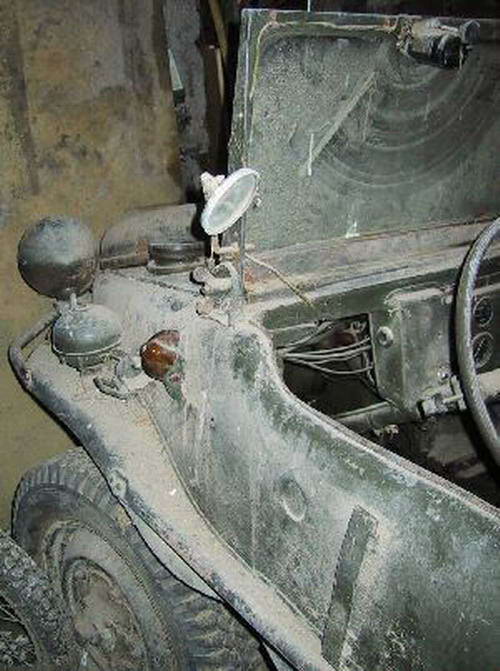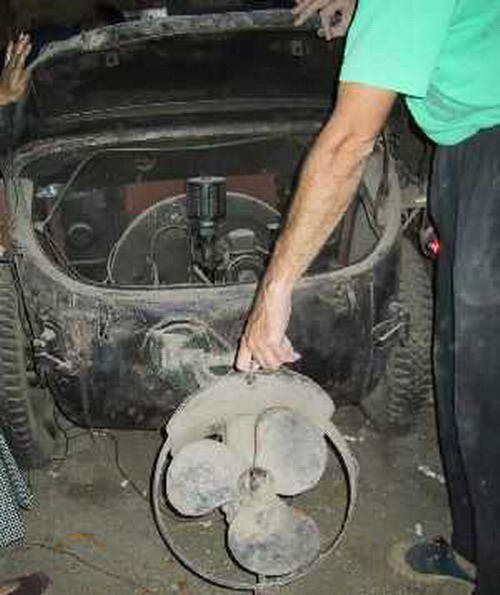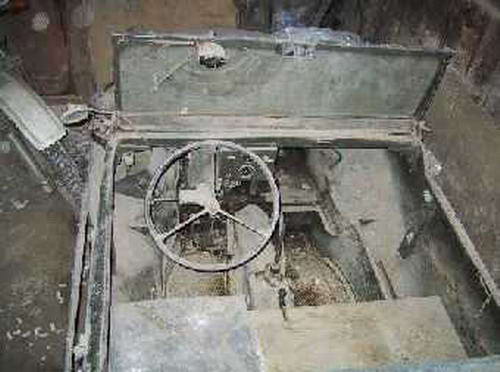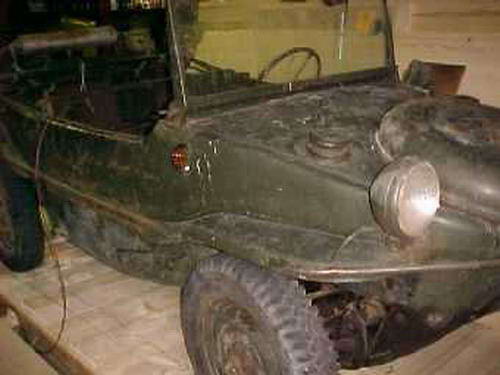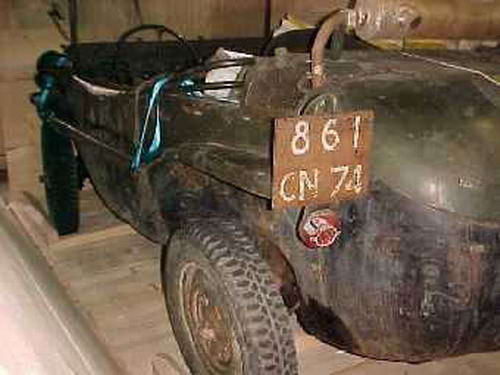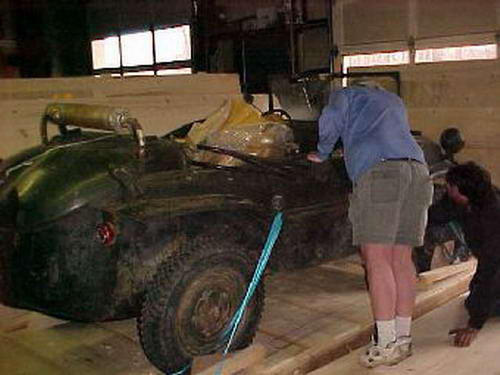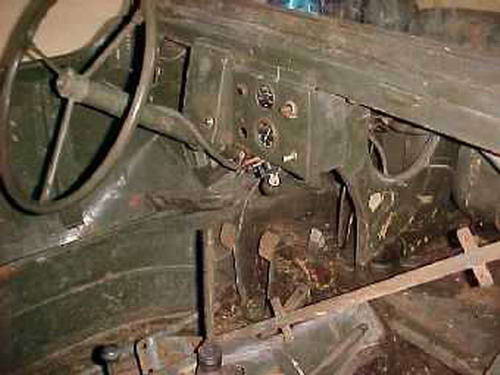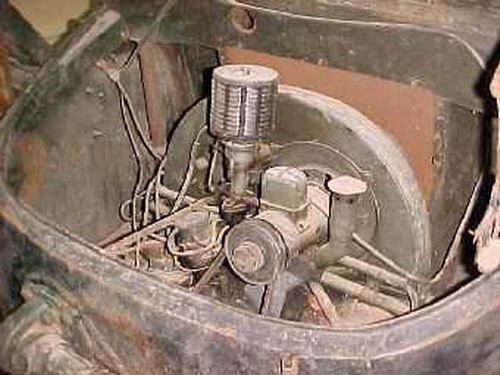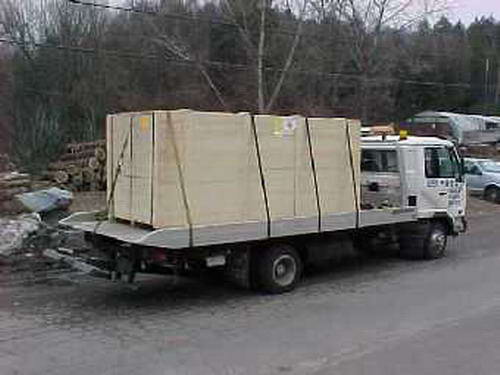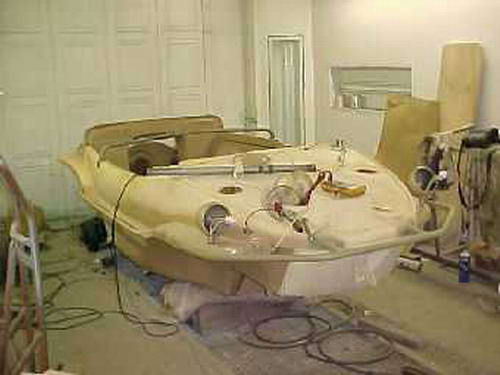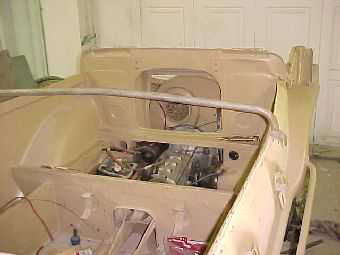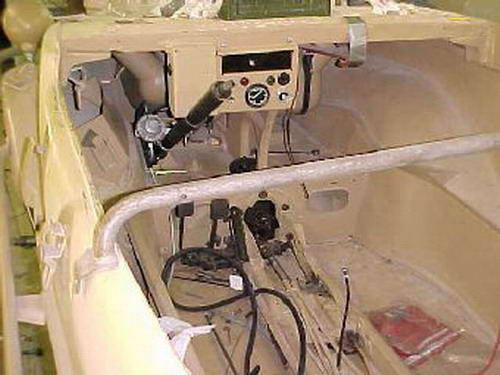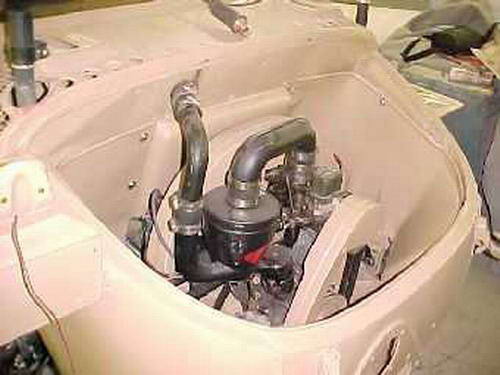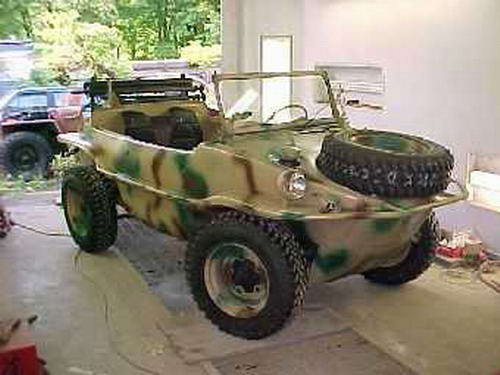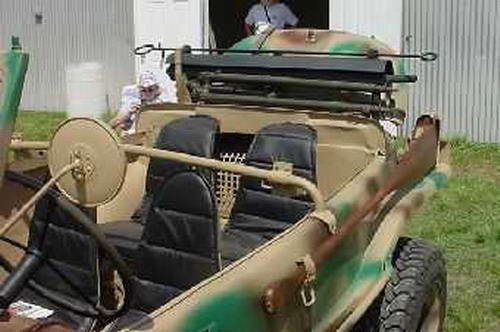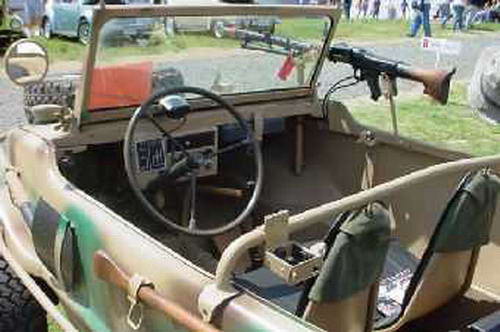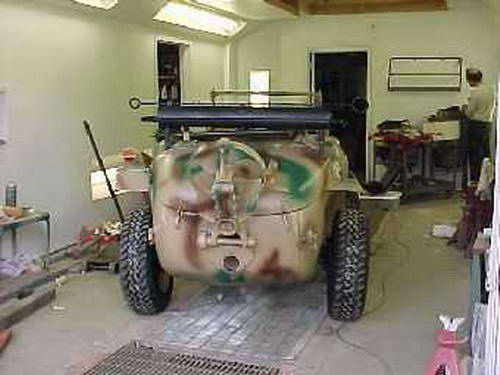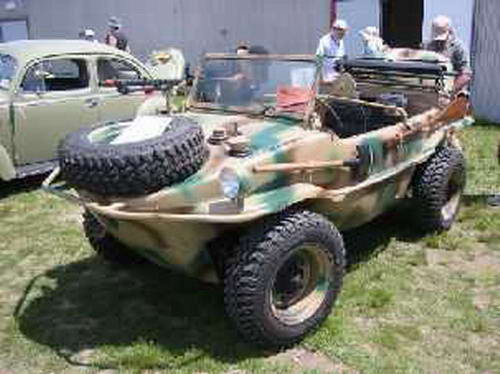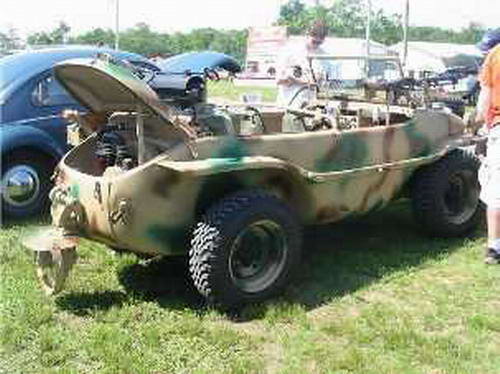Restorations
Schwimmwagen restorations
Restorations
Schwimmwagen from Diekirch, Luxembourg
National Museum of Militairy History -Diekirch- http://www.nat-military-museum.lu/
Text and pictures have been kindly provided by Mr Roland J. Gaul, the curator of the National Museum of Militairy History -Diekirch, Luxembourg
Part I (2004)
"Worldwide WWII military vehicle collectors only know too well that German VW type 166 amphibious cars or "Schwimmwagen"s are very hard to come by. In 1984 the volunteers of the National Museum of Military History were uncommonly lucky when discovering an – albeit strangely modified specimen – virtually under a pile of straw in a barn of a small village some 15 KMs north of Diekirch."
VW-166 scrap: The vehicle stored for many years at the museum's depot in the condition as found in 1986.
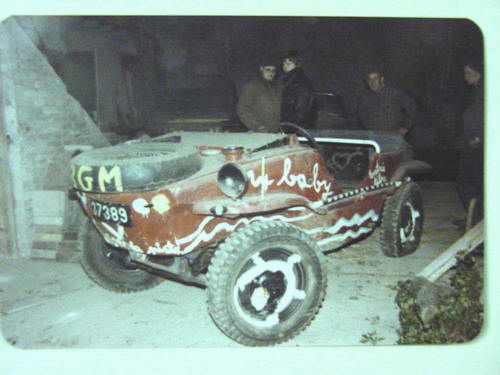
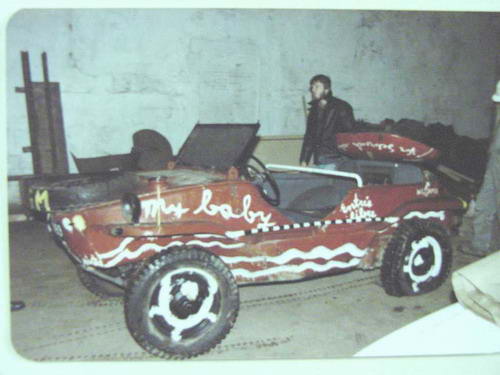
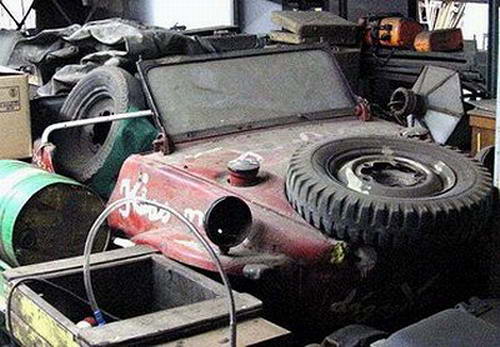
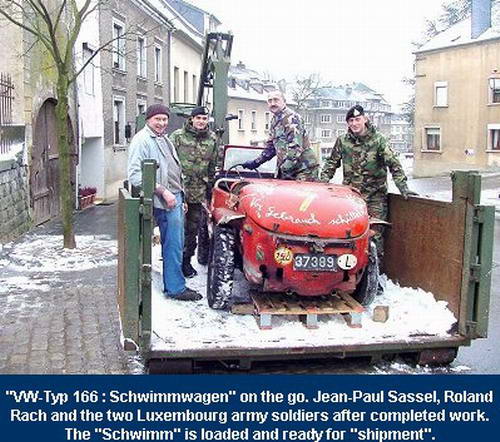
"It turned out that the hidden "treasure" was actually an original VW-166 "Schwimmwagen" that had been "resting" there since 1951, when it was "decommissioned" after serving for 4 years in a row in various regional post WWII carnival parades. (This was confirmed by numerous elder fellow-citizens, who remember the vehicle well). With the sides cut out, numerous accoutrements removed, painted bright red with several weird and ironic white inscriptions (such as "shake before use"), the "Schwimm" – after surviving the "Bulge" – had once been a "star" and a key focus during the late 40s’ carnivals, when people tried to forget about the horrors of war. Realizing what an unusual "gem" they had discovered, the museum volunteers joined all their savings to come up with an appropriate sum to acquire this "old warrior". But for other priorities inside the budding museum, there was never enough funding, time and other resources to "cosmetically" restore the "Schwimm" to
its original condition at that time. For years it had been a sitting duck in the museum’s storage facilities, always admired and sought after by numerous interested foreign collectors. No way would the museum give it away! Actually it was found out, that the abandoned vehicle came from the Diekirch area, where it was most likely abandoned by the 352nd German Volksgrenadierdivision in January 1945 during Gen. Patton’s 3rd Army’s counterattack in the Sauer river sector.On January 13, 2003, the "carnival-lized" "Schwimm" was finally moved by Jean-Paul Sassel and Roland Rach, assisted by two Luxembourg army soldiers from its 20 year-long depot to be loaded on a Luxembourg army MAN roll on-roll off container truck for a brief temporary storage facility. "
"Within the coming months it will be moved to Germany, where – thanks to the "Bundeswehr" (Federal German army) it will be completely rebuilt and restored to original condition in a mechanical workshop with numerous missing parts being supplied in turn by the Diekirch museum. It is estimated that the restoration works may take up to two years, but this will be worth the effort and time, given the rarity of that interesting vehicle. We’ll keep you posted. "
Part 2:
" The National Museum of Military History is now enriched by an original 1944-built German VW-166 "Schwimmwagen" (amphibious staff car), as the worldwide database on remaining VW “Schwimmwagens” on www.vw166.com is enlarged by one unit.
It was two years after the official initial opening of the museum in 1986 that a heavily-wrecked (but still recognizable) VW-166 was found in a barn in the Luxembourg Ardennes, long-forgotten for many years. The vehicle had been scrapped, painted red with many graffiti and had apparently served as a funny point of attraction in a 1948-held Carnival parade. Further research revealed that the actual vehicle was abandoned most likely for mechanical breakdown at the outskirts of Diekirch in late January 1945 by the retreating German troops, where a farmer had “salvaged” the vehicle and later on sold it to an individual.
Decades later, the museum volunteers acquired the remains of the VW-166 and stored it pending proper restoration and procurement of rarer spare parts. It was thanks to the kind assistance of the German military attaché’s office of the German Embassy in Luxembourg that contact was established by the former SIZ 860 (mechanical repair shop) of the German army in St. Wendel, Germany.
This large maintenance unit – now a civilian institution – has an apprentice school for future mechanics and car repair specialists. The management SIZ 860 agreed to put the old warrior up to snuff again and accepted the wrecked vehicle with a batch of newly-made spare parts. Under the expert guidance and supervision of masters Mr. Bommer, Mr. Mosmann, and Mr. Schneider, some 50 young German trainees worked countless hours during a 3-year period to fix the “Schwimmwagen”. The “wreck” was completely taken apart, sandblasted, primed, and step-by-step reassembled with numerous larger missing parts being made at SIZ 860. The result was amazing: the phoenix re-emerged from the ashes, as a fully functional cross-country staff car. "
" On July 13, 2006 during a small ceremony, the vehicle was officially turned over to the museum in presence of the German military attaché, Lt. Col. Metz, the mayor of Diekirch, the museum volunteers and of course, the masters and some 40 apprentices of SIZ 860. The vehicle was jointly unveiled by a group of trainees and volunteers of the museum and an outdoor barbecue in honor of SIZ-860 was offered to all attendees."
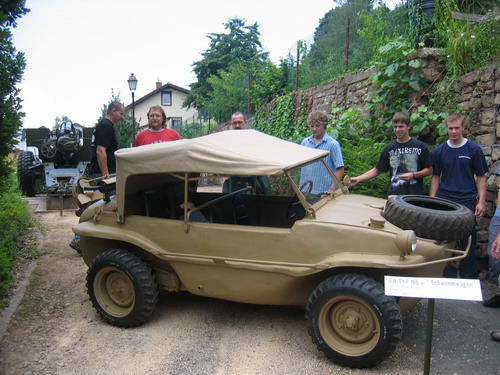
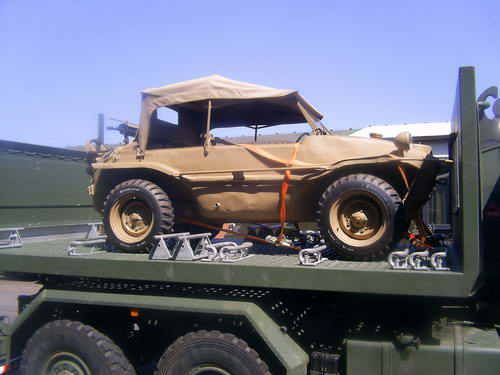
The "Schwimmwagen" handing over ceremonys.
A moment after the official joint unveiling.
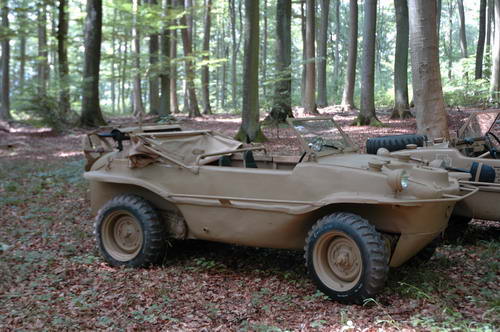
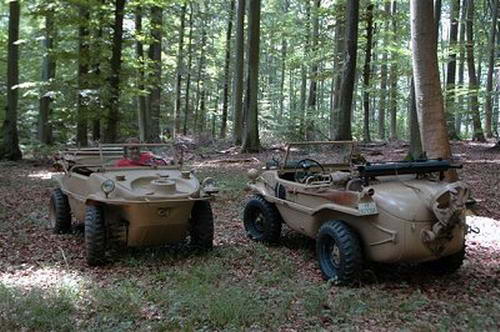
The restored "Schwimmwagen" is tested by museum volunteer,
Marion Schaaf.
VW-166 "Schwimmwagen" MEETING" in the "Seitert" woods north of Diekirch. The other superbly-restored vehicle belongs to well-known Luxembourg collector, Jean Ziger.
" The restored vehicle will now be “camouflaged” and correctly stencilled by the museum staff with several accoutrements added (MG 34 and MG 42) to be put on permanent display towards the end of the year. "
For more interesting information regarding we highly recommend to visit the website of the National Museum of Militairy History -Diekirch-:
http://www.nat-military-museum.lu/
Restorations
Schwimmwagen Found in the French Alps
Text and pictures have been kindly provided by Mr George Murtha
Exactly 15,125 VW Type 166 better known as Schwimmwagens were manufactured during World War II. At the conclusion of the war, all the vehicles that could be found were crushed or used for target practice by the Allied Forces. Consequently only 125 or so examples survive today.
I bought my first Schwimmwagen in the mid 70s from a gentleman who worked as a translator for the United Nations. Actually, I didn?t buy it. I traded him the car for a harpsichord. The vehicle fascinated me. Being a car collector, it was a most unusual find and I enjoyed it. I kept the car for a while and then sold it to a gentleman in Washington , DC who had a second Schwimmwagen. He was very ill and he looked at them out the window of his room. At that time of his death his widow sold them both. One went to Florida and the other to Toronto . I do not know which one was my first Schwimmwagen and I always regretted selling the car.
The good news is that the person from whom I bought the first Schwimmwagen owned two of them. One being the car that I bought 30 years ago in the US and the other one that was in storage on his farm in the French Alps. He had left it sitting in the barn when he drove it for the last time in 1959. It had been his everyday driver up to that point until his wife refused to ride in it any longer. He had not started it since that day he parked it 40 years ago and he had not seen it for the past many years.
I remained good friends with the gentleman who is now quickly approaching 90 years of age. When I saw him in the summer of 2001, he told me that some Frenchmen had found the car and were attempting to buy it but didn't have adequate funds to do so but they were working on it. I asked him how much he wanted for it and agreed to pay him his asking price. Even though we are good friends, he said he would do nothing to help me get the car and I was on my own with the purchase and delivery to the US . I agreed and worked to find a shipper to pick up the car and deliver it to me in the US . Eddie Daepp of Car Logistics in Switzerland was recommended and I hired him to move the car. The beginning of December 2001, a car carrier was sent to pick up the car high in the Alps before the snows came and the roads became impassable. The owner of the car, who now lives in Geneva , had not been to his farm for many years but he did agree to accompany the trucker. When they arrived at the car, he took the key out of his pocket where he said it had been for 40 years. He attempted to start the car but obviously the battery had long gone dead and he commented "the battery must be flat" when the car would not start. The car was flatbedded to Switzerland and crated before being transported to Rotterdam for the ocean part of the journey.
Two months after it was picked up on the farm in France it arrived in Port Elizabeth ,New Jersey . A-1 Towing of Canton Connecticut picked up the crated car on a snowy day in February. After bribing the person on the docks who infomed me he would not be able to give me the car until the snow stopped unless I was prepared to buy him breakfast, we loaded up the car and were on our way home. The shipping company would not allow me to open the box on their premises so we delivered the large crate to Connecticut and cut it open with a chain saw. When the crate was open, I saw the car for the first time.
I was very surprised as to the condition of the car. It was rust free and reasonably complete (or so I thought at the time). The car had been driven daily by my friend and prior to that it was the daily driver of the "young hippy type" he bought it from. It had been modified to meet the requirements for a French registration after the war. I also think it had been used as a tractor at some point as the suspension had been modified to carry a lot more weight and the interior of the car was badly damaged from carrying cargo. The seats were missing and had been replaced with a bench seat. The dash was missing. The windshield had been widened and changed for better weather protection. French headlights, horn, and many other items had been changed and the propeller drive lost when the original engine was removed and replaced with a correct engine but not the original engine. Also all traces of the car?s military history had been removed.
I cleaned the car and delivered it to Bob?s Foreign Car in New Hartford, Ct. After rebuilding the carb, adjusting the valves and putting some fresh gas in it, Bob had the car running in a very short time and he drove it around the block. It ran very well and the original cable brakes worked perfectly. Not having any idea what was correct and what was incorrect with the car I began doing research as to how to begin the restoration.
I talked to Chuck Pisconski from Vintage VW who said there was a person in Michigan who restored Schwimmwagens and Kubelwagens, but he could not remember his name. He ultimately found the information and I called Dave Crompton, who is a wonderful person and has become a very good friend. I booked airline reservations and flew to Michigan to spend a few days at Dave?s shop as there were several Schwimmwagens there undergoing restoration. I photographed them extensively so I now had pictures of every nut and bolt on the cars. I also looked at the correct parts for the car and realized how much of my car was incorrect. I bought many of the parts that I knew I needed. Some of these I brought back on the plane with me and the rest Dave UPSed to me over the next few weeks.
When the Schwimmwagen arrived in Connecticut , the car looked as if it had been parked in the middle of a golf driving range and used as a target for many years. It was dented from front to back and the back of the car was twisted and torn. The front of the car had been torn off at some point and the metal replaced with a flat piece of steel. The car was totally disassembled and sand blasted. It took several months for Wes Zadora at Bob?s Auto Body to beat out the dents and get the car reasonably straight. After the interior was painted the original tan, the car was moved to the mechanical shop to begin that stage of the restoration.
I was continually finding and buying parts. Dave Crompton was able to provide many of the things that I needed and I had a package arriving from him almost daily. I also found parts that he did not have from a large number of people in Europe . Other Schwimmwagen owner?s were very quick to help. If I had a question I would email someone and I would get an immediate answer and photographs to show what was correct. Dale Taylor from Ohio was a great resource and I have extensive photographs showing his car which was restored a few years ago. . After I had successfully located the mechanical parts, I then concentrated on finding the add on parts that originally came with the car. I bid on many items that appeared on German eBay.
The Schwimmwagen carries a machine gun mount behind the rear seats. I was the high bidder on the item and Wolfgang Nertinger, who listed the item has become a great friend even though I have not met him as of yet. He has provided me with parts and information that were not available in this country.
The car was finally mechanically completed on June 13th and it received the green and brown camouflage paint job. The following day it was driven to the Harwinton VW show and competed in the concours where it won 1st place in class. It has since been at two more shows where it also won. It is now being driven on a regular basis.
In August, 2002 I attended the 14th annual Kubel Korp meeting in Ohio and once again learned many things about the vehicle that I did not know before. I also went for my first Schwimmwagen ride in the water. I attended the meet again this August still without the car as there are some mechanical issues that have to be resolved.
These will be addressed shortly and the car will be ready to drive and show.
I have mixed emotions about putting it in the water. I have no doubt that it will float and be fun but the car has been restored to a very high standard and I don?t want to risk damaging it.
I have kept the previous owner updated on the restoration of the car and he did come from Switzerland to see it half way through the restoration.
Restorations
UK Schwimmwagen
Restoration of Schwimm 15410 – part 1
In late 2007, a schwimm was advertised on Bart’s inestimable website, vw166.com. At this point, I had been looking for a schwimm for almost 2 years and had reconciled myself to the fact that it was unlikely I would ever get one, especially as prices seemed to be rapidly rising out of my reach!
15410 was obviously a restoration project but from the photos seemed complete. The sale was to be made to the highest bidder and so I lodged my bid and was surprised to find it was the highest. At this point however, the owner was not quite ready to sell and so a number of months passed until just before Easter 2008 when I received an email telling me that 15410 was mine and could be collected!! I could not stop smiling. Cash was transferred, trailer rented and ferries booked. Myself, a friend, my daughter and her friend made the journey from UK to just south of Paris where 15410 lived. As we approached the location, I began to feel nervous, I had at this point only seen a few photos of the car and so did not know really what to expect.
We arrived at our destination et voila! In a barn, we found 15410 where she had lived for the past 20 years.
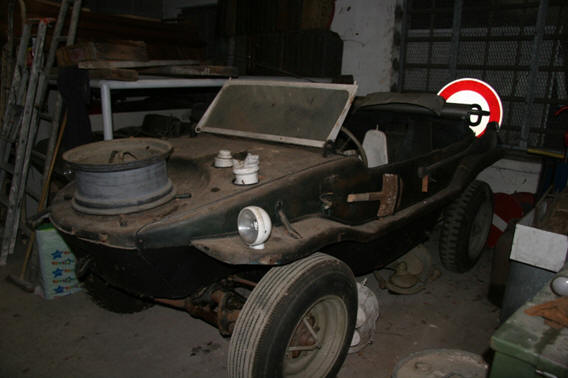
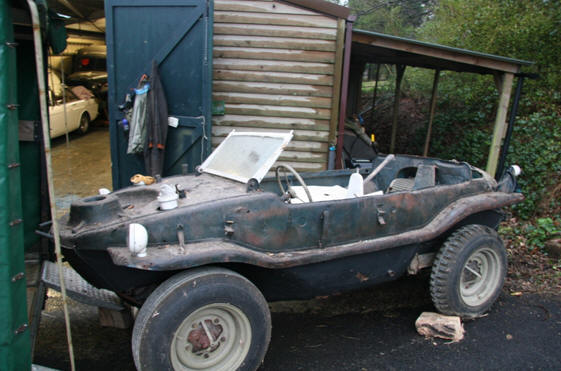
Unfortunately, the owner was unable to share any history of 15410 with me save for the fact he had owned her for 20 years and in that time, it seemed, had been unable to complete her restoration.
The car seemed fairly original and unrestored. The body appeared to be complete and in reasonable condition, there being some obvious rust problems but nothing too serious. Whilst relatively complete, some ‘cosmetic’ parts were missing, e.g. couple of seats, gearbox cover, roof and frame etc. However, all the major components seemed to be present – body, windscreen, gearbox, engine, propeller unit.
So she was pushed out into the daylight to begin the journey to her new home
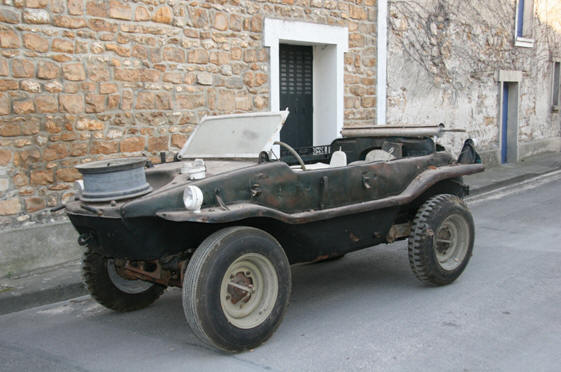
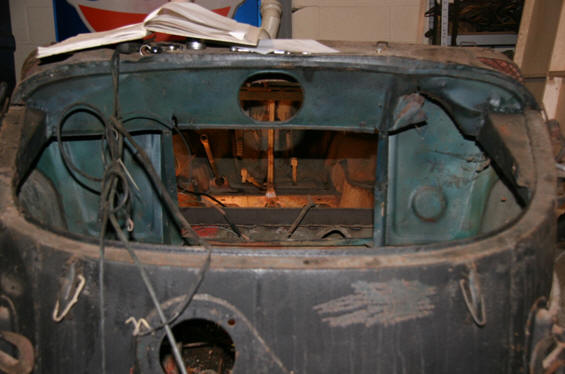
Things I liked about her:
- wide wheels which I prefer
- wider mudguards marking her out as a late production model
- the fact she was mine!
400 miles later, she was at her new home which she will now share with new friends!
So, having got her home, I could now start the work. Learning from experience of previous restorations, it is important to do several things:
1. Maintain the momentum – it is easy to push projects to the back of the garage and forget. So I have set myself a target. Normandy 2009.
2. Keep notes during tear down – I always say this, I never do it. This time is different as the reference material is not as freely available as for other vehicles like Jeeps.
3. Box the parts and label them – Again, easy to say, not always done. Am forcing myself to do it this time……
So the dismantling began. And was relatively straightforward, there being no seized bolts apart from 1 rear shock absorber bolt. Everything came apart very easily. Inside 1 day, I was already down to the bare shell. By this stage, the initial euphoria of purchase had worn off and the grim reality of the restoration had set in. I could now find that some things were not as they seemed:
The engine is a 51 Beetle, not a schwimm engine
The dashboard panel had been cut out and replaced with an piece of L section iron
- Whilst the driver side dashboard bracket is present and seems original, there is no Fahrstelling nummer stamped into it
More rust problems became apparent when engine, gearbox, running gear are removed
- Whilst engine deck lid is original Schwimm, the body number does not match my body number
Now fully stripped, it is time for sandblasting to reveal the true state of the bodywork.
Well, what returned from the sand blasters was not exactly what I had hoped for. The sandblasting removed the paint, rust and filler already applied to the body over the years to reveal the following problems:
1. Below the waterline, the driver side is a mass of welded on patches to cover the pinhole perforations revealed by the sandblasting. This patching has not been done in a professional way, it is simply big plates of metal slapped on and arc welded in place.
2. The passenger side is also plated but nowhere near as badly and the wheel arch is in good shape
3. The rear driver wheel arch looks like someone attacked it with a hammer and a gas torch
4. The front deck under the wheel hump is lacework
5. The front deck itself, looks like the result of a failed origami lesson, it looks exactly like a crumpled sheet of paper that has been straightened out…badly. It is also perforated all over
6. The inner driver side longitudinal rib is toast. It has been massively (and crudely) plated to retain integrity but it is basically scrap
7. Someone has previously removed the front deck by the expedient of putting a gas torch through the dash section (hence the L section iron dash) and through the central rib under the deck so half is attached to the top deck and half is attached to the tub…
On the positive side, we can now see what needs to be done! Replacement panels ordered from a variety of sources.
15410 is now at the body shop where work will commence in the next couple of weeks on restoration retaining as much of the original metal work as possible.
So, at this point what do I know about 15410? The reality is not much but here is the summary
- No fahrstelling number – original dash bracket is present but not stamped and there is no chassis plate (although the engine room panel has the holes for the chassis plate rivets)
- Aufbau 15410 which I think is the highest recorded number in the registry
Engine lid number 3886
- Gearbox number is 7-013953 (although it is unclear if this is the original gearbox)
- All my wheels are dated between May and November 1943 (revealed by sandblasting)
- Inside, there were traces of green paint which may or may not be original
- Late body details include: No stop pocket, dash with late style tool box bracket, no passenger side rear light mounting (and no evidence of one being fitted), wide mudguards, additional mudguard supports underneath the mudguards, no side rail, rounded front rail, horn mount welded to driver side front wing, small headlights
It has been suggested that given the high aufbau and green paint, this could be one of the schwimms assembled and used after the war by the British Army. Photos of these schwimms have all of the same body details as mine and the green paint inside the engine bay is perhaps further evidence. A known British assembled schwimm has an aufbau very close to mine. It was also suggested that the absence of the stamped fahrstelling could have been because those assembled by the British were not ‘production line’ models and so might not have received a production fahrstelling nummer. Vince has challenged me to rebuild 15410 in British army configuration, i.e. paint her dark green…….but I think I prefer the sand colour…….
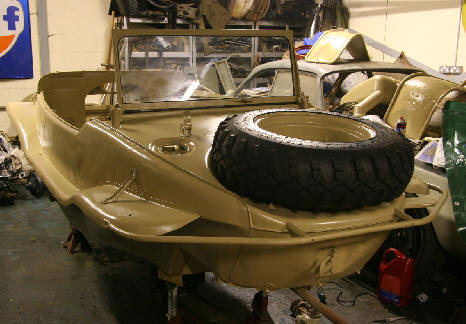
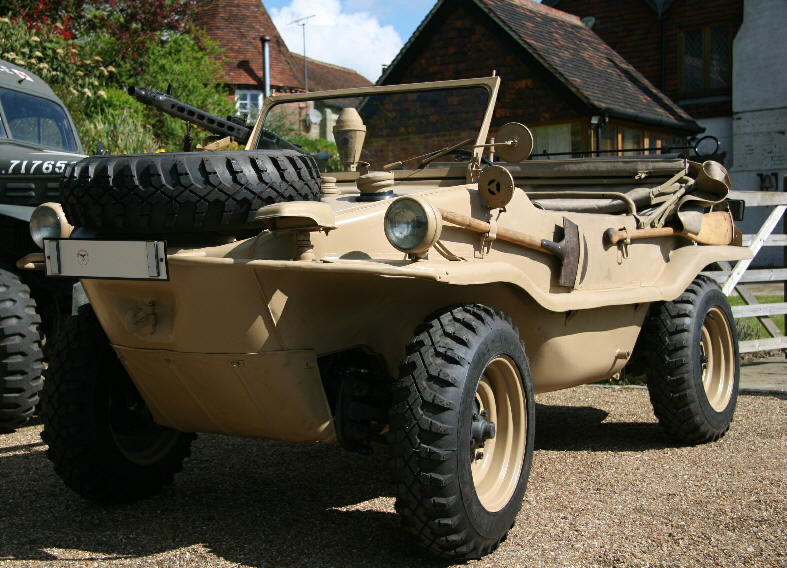
Restoration
Please share your schwimmwagen pictures


